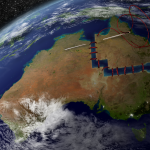Fresh thinking needed on how to break the cycle of poverty
Almost one quarter of all Australians are living under the poverty line. Sally Cowling from UnitingCare shares the results of research showing a worrying trend of more children than ever before living in poverty.
For Anti-Poverty Week in Australia (13 to 19 October 2013) my organisation, UnitingCare Children Young People and Families (UnitingCare CYPF), contributed by releasing a report on ‘Poverty, Social Exclusion and Disadvantage in Australia’, jointly with the National Centre for Social and Economic Modelling (NATSEM).
The report revealed that in 2011-12, almost one quarter (618,000) of the 2.6 million Australians living under the poverty line were dependent children aged under 25, and almost half a million (494,000) were children under 15. It also told us that there are concentrations of child poverty and risk of child social exclusion in some of our communities. What is most troubling is that these patterns aren’t changing over time.In 2011-12, child poverty rates were highest (13.9%) when the youngest child was aged 0-2 years.
The unacceptable rates of child poverty should be ringing alarm bells throughout our community. At UnitingCare CYPF, we’ve been involved in taking up the recent work of internationally recognised American psychiatrist, Bruce Perry, who specialises in children’s mental health and the neurosciences. Perry tells us that the experiences of the developing child and their environment have a tremendous impact on their overall development. Hence when a child has adverse experiences (and we would argue that poverty is adverse to a healthy childhood), the disruptions to their neurodevelopment could lead to compromised functioning (Perry, 2009).
The report tells us that more children than ever before are living in poverty. This means an unacceptable number of children are commencing school ‘behind the eight ball’ with significant developmental vulnerabilities.
This is not good enough. We need to invest in tailored early intervention and prevention measures that get children off to a flying start in life. We need to invest in creating access to transport, the learning opportunities provided by the internet, social interactions, health and dental care for children and families in greatest need. Every day our programs work with families living in poverty who are trying their best to provide nurturing environments for their children. Despite their efforts and commitment, poverty can create emotional stress in parents. This makes it much harder to provide the warm and consistent parenting that fosters child development. At the same time, limited resources make it much harder to afford books and toys, quality child care or preschool, leisure activities and excursions.
Our youngest children are at risk of social exclusion. In NSW, the report shows that all but three of the 32 Local Government Areas where children were at highest risk of social exclusion in 2006 are still in the highest risk classification in 2011. We are failing to invest in creating improved life chances for children, families and communities most in need.
As this report demonstrates, child poverty rates have remained unchanged since 2000-2001. This represents a failing of Government approaches to address child poverty. With a new government in Canberra, now is the time to look carefully at new approaches to tackle child poverty.
The question that the report poses for political leaders and policy makers is how in an era of economic growth do we find it tolerable that almost half a million Australian children under 15 years are growing up poor?
* Perry, B.D (2009) Examining child maltreatment through a neurodevelopmental lens: clinical applications of the Neurosequential Model of Therapeutics, Journal of Loss and Trauma, 14, 240 – 255.
Sally Cowling is Manager of Research and Program Development at the Social Justice Unit of UnitingCare Children, Young People and Families (UCCYPF).














LinseyHarbour
May 14, 2014 at 11:15 pm
If you are well educated and
If you are well educated and the government focused on jobs suitable for what the schools offer the poverty that we are experiencing will lessen. If the government will just focus on how to develop the economy for its constituents, those who are below the poverty line will decrease. Article resource: Americans below poverty line is highest number since records began
catch_claire
March 27, 2015 at 5:32 am
Poverty.. It Still Exists!
For many Australians, they have the satisfaction of sleeping in a comfortable bed at night, living with a roof over their heads and access to an abundance of food and drink. However, there are thousands of people who don’t have that privilege. Whilst many of us may not class ourselves as rich or wealthy, our living habits would prove otherwise compared to the many disadvantaged Australians. In a report by the Australian Council of Social Services (2014), they estimated 2.5 million people are living below the internationally accepted poverty line. This means that the individual’s income is less than the deemed adequate amount for Australians. When most people think of the word poverty, they immediately picture Africa; even a simple Google search for the term ‘poverty’ results in images of malnourished children from countries such as Zimbabwe and Liberia. Considering that Australia is one of the most affluent countries in the world, it’s hard to believe that many people go without food and water each day. The harsh reality, however, is that poverty does exist throughout the whole nation. At the beginning of the decade, policy-makers were ignoring the ‘p’ word because of its negative political culture (McClelland & Smyth, 2014).
It’s a heartbreaking veracity that Australians need to be aware of, especially for the Aboriginal communities that live in remote areas that are comparable to third world communities. In recent media reports, Tony Abbott was asked to discuss his plans to shut down these communities. His response was the following: “What we can’t do is endlessly subsidise lifestyle choices if these choices are not conducive to the kind of full participation in Australian society that everyone should have.” (Allan, 2015) They choose to live there because they have connections to the land and it is tradition. Instead of supporting the true Australian culture, he is forcing them to move to major cities where they continue to face unemployment and poverty (Allan, 2015). All this, and yet they wonder why aboriginal communities continue to despise the Australian government. In Australia, the biggest cause of poverty is unemployment. On ABC’s TV show Q and A, Federal Member and Minister for Communications Malcolm Turnball said that the current youth unemployment rate is at 20%, which in his opinion is “too high.” Those words couldn’t be more truthful. Author Smerdon (2015) says that one in five unemployed Australians are adolescents. This is a concern as they play a big part in the growth and welfare of the future. In good news, Scott Morrison, the Minister for Social Services, announced extensive funding towards the National Partnership Agreement on Homelessness (NPAH) for another two years (Caneva, 2015). This agreement works towards early intervention and intervention to stop people becoming homeless. This gives hope to those struggling to find jobs that live in poverty. However this won’t solve the issue. The government should consider reviewing the distribution of welfare payments. Not only is unemployment a contributing factor. For many people living off a minimum wage income is simply not enough (Baum & Duvnjak, 2013). It is the most vulnerable people in our community such as people living with a disability who cannot work, people living with a mental illness that prevents them from working, the elderly community and children that deserve the financial support. Those who can work should be supported and encouraged to work. A fairer distribution of income and welfare is important, not just for poverty and social exclusion in Australia, but to provide equal opportunities for everyone. References Allan, S. (2015). Australian PM attacks “lifestyle choice” of poverty- stricken Aborigines. World Socialist Web Site. Retrieved From: https://www.wsws.org/en/articles/2015/03/17/abbt-m17.html Australian Council of Social Services. (2014). 2.5 million people living in poverty in Australia: new report. Media Releases. Retrieved From: http://www.acoss.org.au/media/release/2.5_million_people_living_in_poverty _in_australia_new_report Baum, F., & Duvnjak, A. (2013). The politics of poverty in Australia. Social Alternatives, 32(1), 12-18. Retrieved from http://search.proquest.com/docview/1447238901?accountid=13380 Caneva, L. (2015). Feds Renew homelessness Program Funding. Pro Bono Australia. Retrieved From: http://www.probonoaustralia.com.au/news/2015/03/feds-renew- homelessness-program-funding# McClelland, A., & Smyth, P. (2014). Social policy in Australia: Understanding for action. South Melbourne, Victoria: Oxford University Press. Smerdon, X. (2015). Youth Unemployment Rising. Pro Bono Australia. Retrieved from: http://www.probonoaustralia.com.au/news/2015/03/youth- unemployment-rising